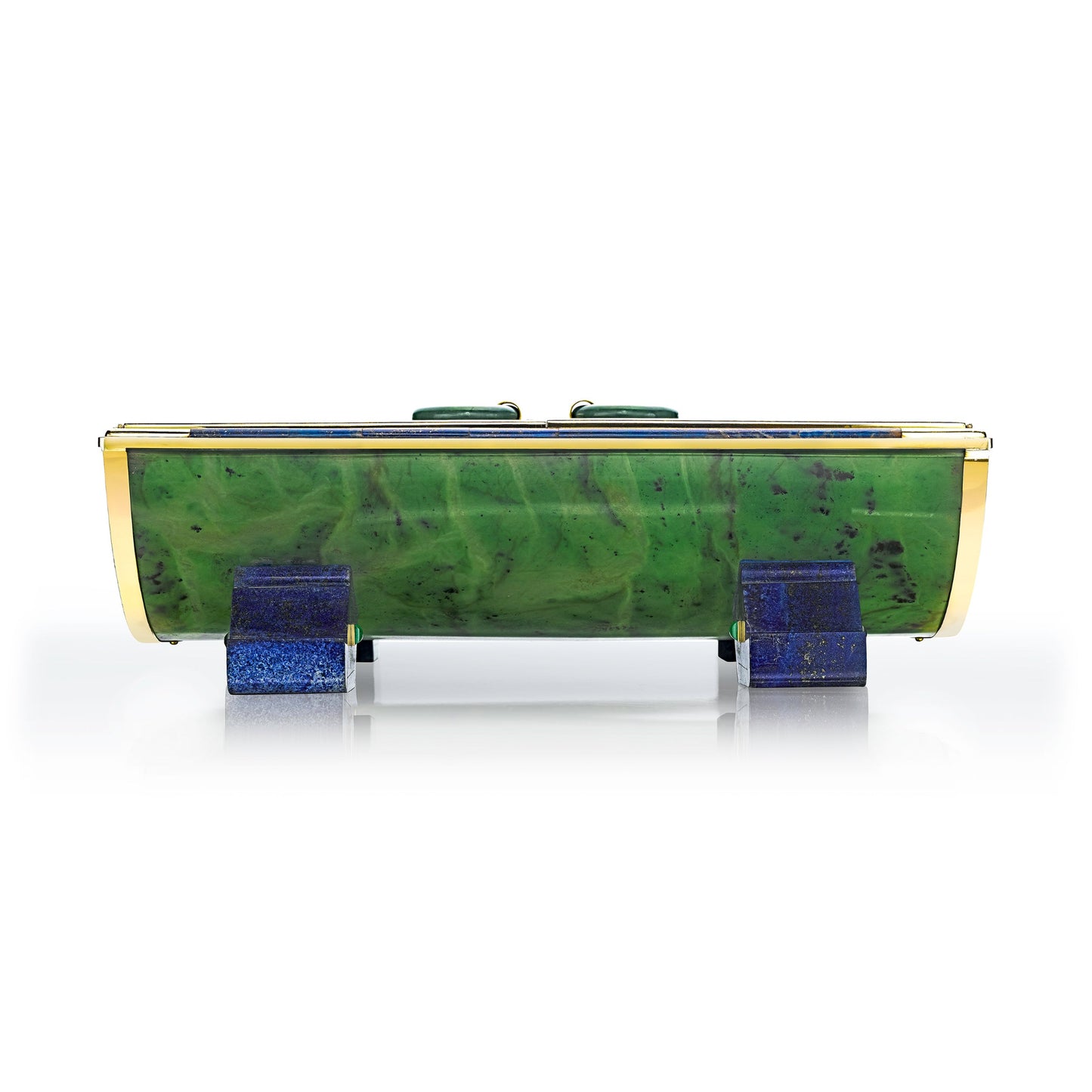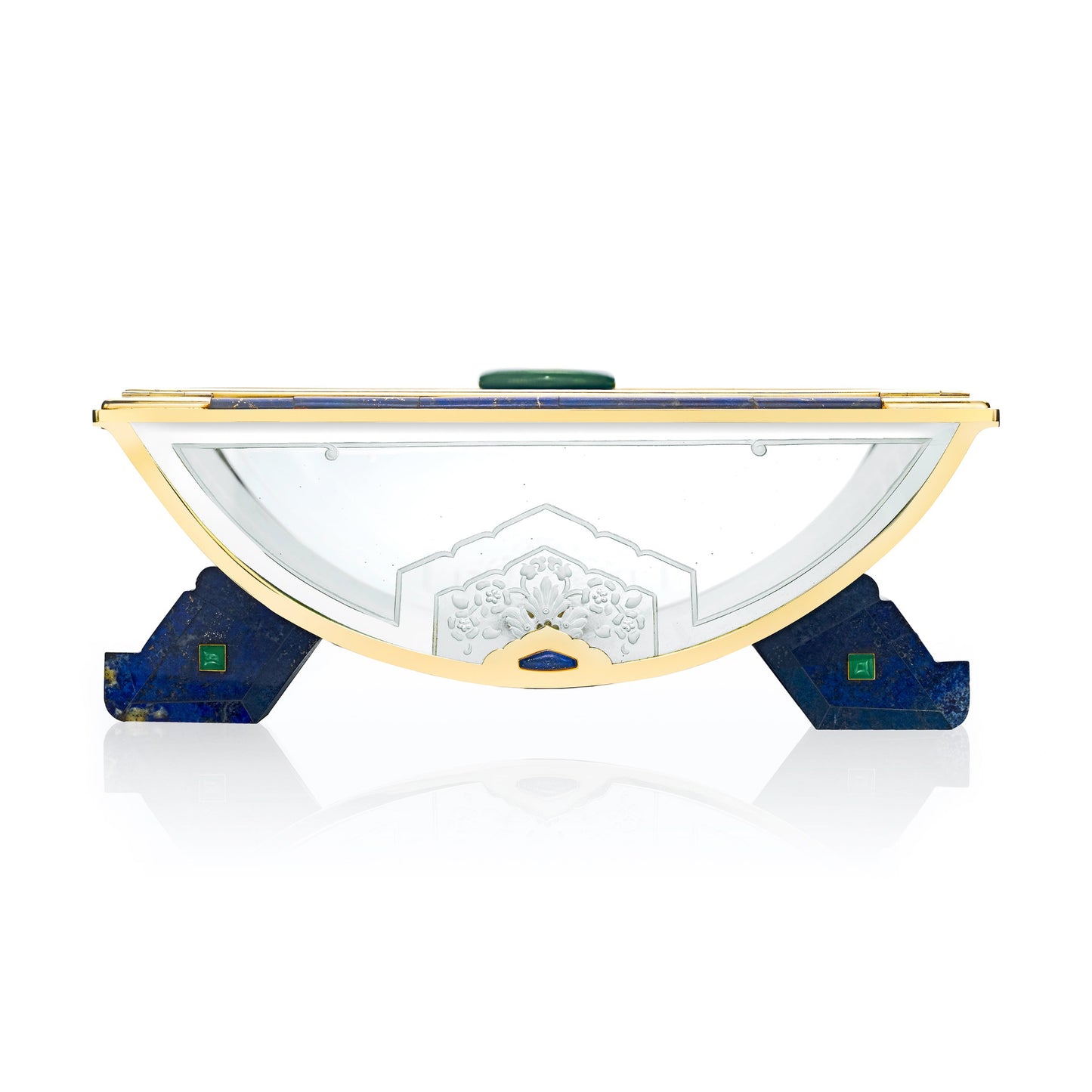Art Deco Crystal, Nephrite, Lapis Lazuli, and Gold Box by Cartier, Paris, circa 1928
Art Deco Crystal, Nephrite, Lapis Lazuli, and Gold Box by Cartier, Paris, circa 1928
A box in the shape of a half cylinder, the base of the box a single curved piece of nephrite, the top composed of two double-hinged frosted crystal panels with a carved foliate motif, set at the center with nephrite hoop pulls centering lapis lazuli cabochons, opening to reveal a single compartment, resting on four lapis lazuli feet; mounted in 18-karat gold, with French hallmarks, in original Cartier red leather fitted box
- Signed Cartier, Paris, Londres, New York, Made in France
- Copy of original Cartier design drawing
- Measurements: 11 3/4 x 9 3/8 x 3 5/8 inches
Additional cataloguing
Literature
Nussbaum. Eric, et. al. El Arte de Cartier: Resplandor del Tiempo. Mexico City: Instituto Nacional de Bellas Artes, 1999, p. 275 & 306 (drawing).
Biography
Cartier was founded in Paris in 1847 by Louis-François Cartier. His three grandsons, Louis, Pierre, and Jacques, built the house into a famous international jewelry empire serving royalty, Hollywood stars, and socialites. Cartier has created some of the most important jewelry and objects of art of the twentieth century with many iconic designs such as mystery clocks, Tutti Frutti jewelry and the Panthère line. In 1983, The Cartier Collection was established with the objective of acquiring important pieces that trace the firm's artistic evolution. Today, Cartier has 200 stores in 125 countries.
Significance
From the company’s founding in 1847, Cartier has offered a variety of decorative and functional objects to their clients. In the Art Deco period, Louis Cartier told his designers, “We must make it our business to build up an inventory that responds to the mood of the public by producing articles which have a useful function but which are also decorated in the Cartier style.” In the 1920s, the booming postwar economy provided spending money for new clients interested in luxury goods for use in daily life.
This table box by Cartier is a fantastic example of a useful object embodying the aesthetic of the Art Deco period with clean lines and geometric shapes featuring a touch of the exotic. A rectangular crystal top with a curved nephrite bottom and lapis lazuli details, the box features the stunning blue-green color combination which Louis Cartier called the “peacock pattern,” inspired by the enameled Mughal jewelry of the seventeenth and eighteenth centuries. Some of the most important jewels created by Cartier in this period, and collected by J. P. Morgan and the Baron de Rothschild, featured the peacock pattern.
A pioneer of design in the Art Deco era, Cartier created impressive pieces during the 1920s, and some of the most stunning jewels and objects incorporated exotic elements. The color combination of this box is so rich, that the use of clear and opaque crystal is a subtle and masterful design move. The crystal is embellished with a meandering floral vine around a clear center evoking a Persian carpet representing a pool of water in a garden or a mihrab, a prayer niche. This box evokes the aesthetic of Persia and India, but reimagined in a modern way by Cartier. This exquisite design embodies the dynamic spirit of the 1920s and features some of the most important Cartier motifs of the era. This is one of the most important and beautiful boxes created by Cartier and would be an extraordinary addition to any collection.







